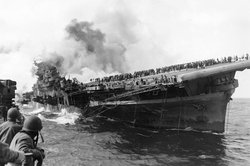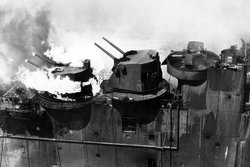USS Franklin (CV-13)
|
|
| Missing image USS_Franklin_CV-13-650px.jpg USS Franklin underway | |
| Career | Missing image USN-Jack.png USN Jack |
|---|---|
| Laid down: | 7 December 1942 |
| Launched: | 14 October 1943 |
| Commissioned: | 31 January 1944 |
| Decommissioned: | 1 October 1964 |
| Fate: | sold for scrap 1966 |
| General Characteristics | |
| Displacement: | 27,100 tons |
| Length: | 872 ft (266 m) |
| Beam: | 93 ft (28.4 m) |
| Extreme Width: | 147.5 ft (45 m) |
| Draft: | 28.7 ft (8.8 m) |
| Speed: | 33 knots (61 km/h) |
| Complement: | 3,448 officers and men |
| Armament: | 12 x 5 inch (127 mm) guns |
| Aircraft: | 80+ |
The fifth USS Franklin (CV-13) (also CVA-13, CVS-13, and AVT-8), nicknamed "Big Ben", was an Essex-class aircraft carrier of the United States Navy, notable as the hardest-hit carrier to survive World War II.
| Contents |
Launch and Commissioning; Initial Cruise
She was laid down on 7 December 1942 and launched by Newport News Shipbuilding, Newport News, Virginia, on 14 October 1943, sponsored by Lieutenant Commander Mildred A. McAfee, USNR, Director of the WAVES, and commissioned on 31 January 1944, with Captain James M. Shoemaker in command. Among the plankowners was a ship's band made up of drafted and enlisted professional musicians of the era, including Saxie Dowell and Deane Kincaide, assigned to Shoemaker by lottery.
Franklin cruised to Trinidad for shakedown and soon thereafter departed in Task Group 27.7 (TG 27.7) for San Diego to engage in intensive training exercises preliminary to combat duty. In June she sailed via Pearl Harbor for Eniwetok where she joined TG 58.2.
Operations in the Bonins and the Marianas
On the last day of June 1944 she sortied for carrier strikes on the Bonins in support of the subsequent Marianas assault. Her planes scored well against aircraft on the ground and in the air as well as against gun installations, airfield and enemy shipping. On 4 July strikes were launched against Iwo Jima, Chichi Jima and Ha Ha Jima with her planes battering the land, sinking a large cargo vessel in the harbor and firing three smaller ships.
On 6 July she began strikes on Guam and Rota to soften up for the invasion forces, and continued until the 21st when she lent direct support to enable safe landing of the first assault waves. Two days of replenishment at Saipan permitted her to steam in Task Force 58 (TF 58) for photographic reconnaissance and air strikes against the islands of the Palau group. Her planes effected their mission on the 25th and 26th, exacting a heavy toll in enemy planes, ground installations, and shipping. She departed on 28 July en route to Saipan and the following day shifted to TG 58.1.
Although high seas prevented taking on needed bombs and rockets, Franklin steamed for another raid against the Bonins. 4 August bode well, for her fighters launched against Chichi Jima and her dive bombers and torpedo planes against a convoy north of Ototo Jima rained destruction against the radio stations, seaplane base, airstrips and ships.
A period of upkeep and recreation from 9 to 28 August ensued at Eniwetok before she departed in company with carriers Enterprise (CV-6), Belleau Wood (CVL-24) and San Jacinto (CVL-30) for neutralization and diversionary attacks against the Bonins. From 31 August to 2 September spirited and productive strikes from Franklin inflicted much ground damage, sank two cargo ships, bagged numerous enemy planes in flight, and accomplished photographic survey.
Support of Peleliu Operations
On 4 September she onloaded supplies at Saipan and steamed in TG 38.1 for an attack against Yap (3-6 September) which included direct air coverage of the Peleliu invasion on the 15th. The group took on supplies at Manus Island from 21–25 September.
Franklin, now flagship of TG 38.4, returned to the Palau area where she launched daily patrols and night fighters. On 9 October she rendezvoused with carrier groups cooperating in air strikes in support of the coming occupation of Leyte. At twilight on the 13th, the task group came under attack by four bombers and Franklin twice was narrowly missed by torpedoes. An enemy plane, a harbinger of the coming kamikaze campaign, crashed Franklin's deck abaft the island structure, slid across the deck and into the water on her starboard beam.
Support of Leyte Operations
Early on the 14th a fighter sweep was made against Aparri, Luzon, following which she steamed to the east of Luzon to neutralize installations to the east prior to invasion landings on Leyte. On the 16th she was attacked by three enemy planes, one of which scored with a bomb that hit the after outboard corner of the deck edge elevator, killing 3 and wounding 22. The tenacious carrier continued her daily operations hitting hard at Manila Bay on 19 October when her planes sank a number of ships, damaged many, destroyed a floating drydock, and bagged 11 planes.
USS_Franklin_hit44-700px.jpg
During the initial landings on Leyte (20 October) her aircraft hit surrounding airstrips, and launched search patrols in anticipation of the approach of a reported enemy attack force. On the morning of 24 October, in the Battle of the Sibuyan Sea, her planes formed part of the waves that attacked the Japanese First Raiding Force (Vice Admiral Takeo Kurita), in so doing helping to sink Japanese battleship Musashi south of Luzon, and damage battleships Fuso and Yamashiro, and sink destroyer Wakaba. As further enemy threats materialized in another quarter, Franklin, with TGs 38.4, 38.3, and 38.2 sped to intercept the advancing Japanese carrier force and attack at dawn. Franklin's strike groups combined with those from the other carriers on 25 October in the Battle off Cape Engaņo to damage the carrier Chiyoda (she would be sunk by American cruiser gunfire subsequently) and sink the small carrier Zuiho.
Retiring in her task group to refuel, she returned to the Leyte action on 27 October, her planes concentrating on a heavy cruiser and two destroyers south of Mindoro. She was underway about 1,000 miles (1,600 km) off Samar on 30 October when enemy bombers appeared bent on a suicide mission. Three doggedly pursued Franklin, the first plummeting off her starboard side, the second hitting the flight deck and crashing through to the gallery deck, showering destruction, killing 56 and wounding 60; the third discharging another near miss at Franklin before diving into the flight deck of the Belleau Wood.
Both carriers retired to Ulithi for temporary repairs and Franklin proceeded to Puget Sound Navy Yard arriving 28 November 1944 for battle damage repairs. In the meantime, on 7 November, Captain Leslie H. Gehres had relieved Shoemaker as commander.
She departed Bremerton on 2 February 1945 and after training exercises and pilot qualification joined TG 58.2 for strikes on the Japanese homeland in support of the Okinawa landings. On 15 March she rendezvoused with TF 58 units and 3 days later launched sweeps and strikes against Kagoshima and Izumi on southern Kyushu.
The Attack of 19 March 1945
Before dawn on 19 March 1945, Franklin, who had maneuvered to within 50 miles of the Japanese mainland, closer than had any other U.S. carrier during the war, launched a fighter sweep against Honshu and later a strike against shipping in Kobe Harbor. Suddenly, a single Yokosuka D4Y ("Judy") dive bomber pierced the cloud cover and made a low level run on the ship to drop two semi-armor-piercing bombs. One struck the flight deck centerline, penetrating to the hangar deck, effecting destruction and igniting fires through the second and third decks, and knocking out the combat information center and airplot. The second hit aft, tearing through two decks and fanning fires which triggered ammunition, bombs and rockets.
Franklin lay dead in the water, took a 13° starboard list, lost all radio communications, and broiled under the heat from enveloping fires. Many of the crew were blown overboard, driven off by fire, killed or wounded, but the hundreds of officers and enlisted who voluntarily remained saved their ship through sheer valor and tenacity. The casualties totaled 724 killed and 265 wounded, and would have far exceeded this number except for the heroic work of many survivors. Among these were Medal of Honor winners, Lieutenant Commander Joseph T. O'Callahan, S.J., USNR, the ship's chaplain, who administered the last rites organized and directed firefighting and rescue parties and led men below to wet down magazines that threatened to explode, and Lieutenant (junior grade) Donald A. Gary who discovered 300 men trapped in a blackened mess compartment, and finding an exit returned repeatedly to lead groups to safety. Gary later organized and led fire-fighting parties to battle the blazing inferno on the hangar deck, and entered number three fireroom to raise steam in one boiler, braving extreme hazards in so doing. Santa Fe (CL-60) similarly rendered vital assistance in rescuing crewmen from the sea and closing Franklin to take off the numerous wounded and nonessential personnel.
Return to the United States for Repairs
Franklin was taken in tow by Pittsburgh (CA-72) until she managed to churn up speed to 14 knots (26 km/h) and proceed to Ulithi and then to Pearl Harbor where a cleanup job permitted her to sail under her own power to the Brooklyn Navy Yard, arriving on 28 April.
Upon the ship's arrival, a brewing controversy over the crew's behavior during ship's struggles finally came to a head; Captain Gehres had accused many of those who had left the ship on 19 March of desertion, even those who had jumped into the water to escape certain death by fire, or had been led to believe that "abandon ship" had been ordered. While enroute from Ulithi, Gehres had proclaimed 704 of the crew to be members of the "Big Ben 704 Club" for having stayed with the stricken ship, but investigators in New York discovered that only about 400 were actually on the Franklin continuously, the others having been brought back before and during the stop at Ulithi. All charges were quietly dropped.
Post-War Status
Following the end of the war, Franklin was opened to the public for Navy Day celebrations and on 17 February 1947 was placed out of commission at Bayonne, New Jersey. While Franklin lay mothballed at Bayonne she was redesignated to an attack aircraft carrier CVA-13 on 1 October 1952, to an antisubmarine warfare support carrier CVS-13 on 8 August 1953 and, ultimately, to an aircraft transport AVT-8 on 15 May 1959. In the end the ship never went to sea again and was struck from the Naval Vessel Register on 1 October 1964.
Although the Navy initially sold the ship to Peck Iron and Metal Company, Portsmouth, Virginia, it re-possessed her due to an urgent Bureau of Ships requirement for the use of her four turbo-generators. Ultimately, however, she was sold, for scrapping, to Portsmouth Salvage Company, Chesapeake, Virginia, on 27 July 1966. She departed naval custody under tow (Red Star Towing Company) on the evening of 1 August 1966.
Franklin received four battle stars for World War II service.
See USS Franklin for other ships of the same name.
Reference
- Steve Jackson, Lucky Lady: The World War II Heroics of the USS Santa Fe and Franklin (New York: Carroll & Graf Publishers, 2003) ISBN 0786710616
- This article includes text from the public domain Dictionary of American Naval Fighting Ships.
External links
- history.navy.mil: USS Franklin (http://www.history.navy.mil/danfs/f4/franklin-v.htm)
- navsource.org: USS Franklin (http://www.navsource.org/archives/02/13.htm)
- USS Franklin website (http://www.ussfranklin.org/main.htm)


